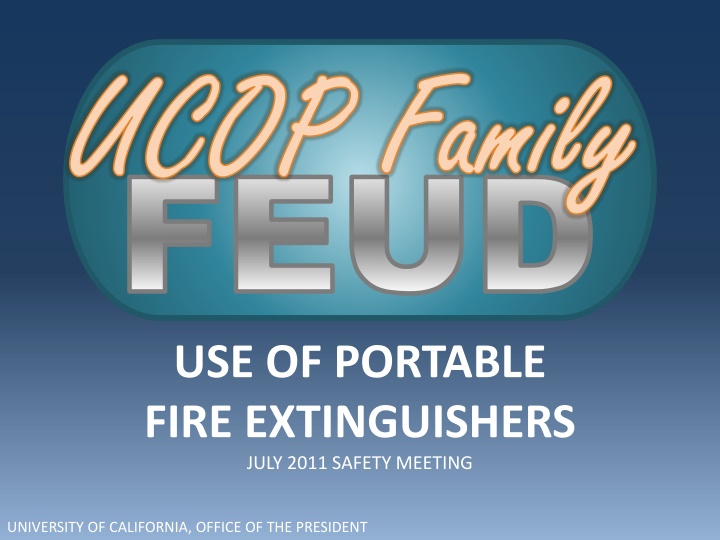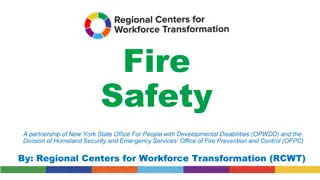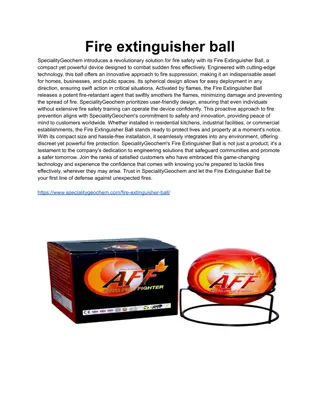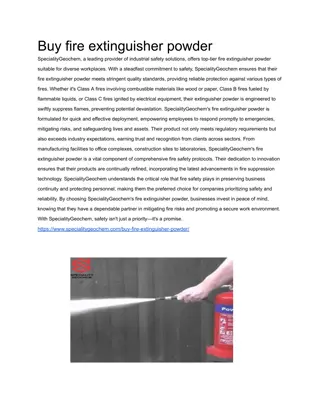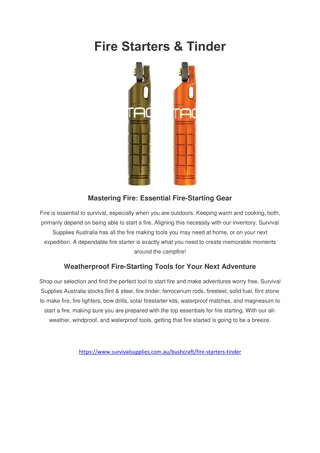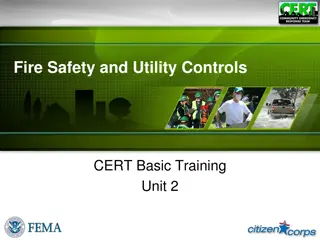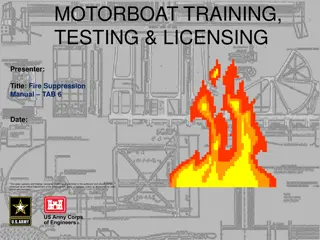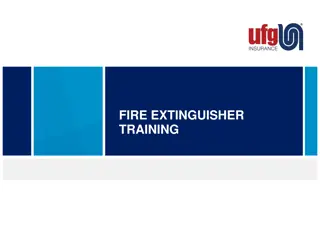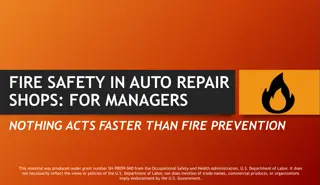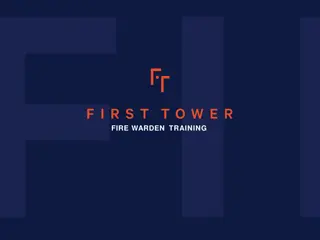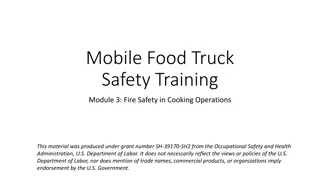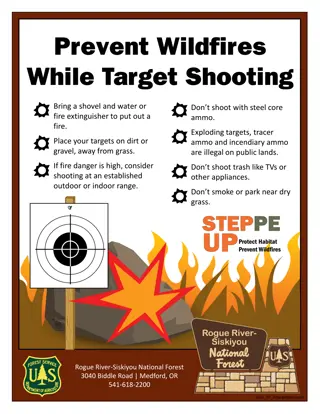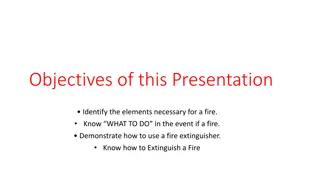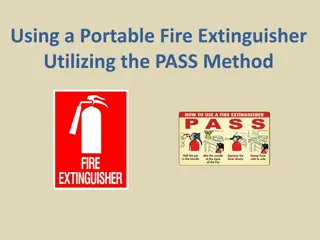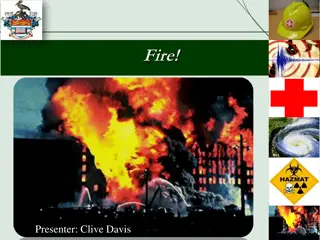Portable Fire Extinguisher Training and Guidelines
Annual portable fire extinguisher training is mandatory to comply with Cal/OSHA regulations. The training covers general principles of fire extinguisher use, when to use a portable fire extinguisher, and examples of different types of fires (Type A, B, C). It also outlines conditions when using a fire extinguisher is appropriate and emphasizes the importance of being properly trained and having a safe escape route. Remember, always ensure the fire is small and contained, know the type of fire extinguisher to use, and confidently operate it effectively.
Download Presentation

Please find below an Image/Link to download the presentation.
The content on the website is provided AS IS for your information and personal use only. It may not be sold, licensed, or shared on other websites without obtaining consent from the author.If you encounter any issues during the download, it is possible that the publisher has removed the file from their server.
You are allowed to download the files provided on this website for personal or commercial use, subject to the condition that they are used lawfully. All files are the property of their respective owners.
The content on the website is provided AS IS for your information and personal use only. It may not be sold, licensed, or shared on other websites without obtaining consent from the author.
E N D
Presentation Transcript
UCOP Family UCOP Family FEUD FEUD USE OF PORTABLE FIRE EXTINGUISHERS JULY 2011 SAFETY MEETING UNIVERSITY OF CALIFORNIA, OFFICE OF THE PRESIDENT
Annual portable fire extinguisher training is required because ? Cal/OSHA regulations Cal/OSHA regulations 1 1 You are expected to use a fire You are expected to use a fire extinguisher at work extinguisher at work 2 2
Fire Extinguisher Use Annual Refresher Training for Use of Portable Fire Extinguisher Cal/OSHA Safety Training Requirement Review: 1) General Principles for Fire Extinguisher Use 2) Guidelines on When to Use a Portable Fire Extinguisher
Name examples of Type A: Combustible Material fires. Paper Paper 1 1 Wood Wood 2 2 Cloth Cloth 3 3
Name examples of Type B: Combustible Material fires. Chemicals Chemicals 1 1 Oil Oil 2 2 Paint Paint 3 3 Grease Grease 4 4
Name most common examples of Type C: Energized Electrical Equipment fires. Appliances Appliances 1 1 Electrical Wiring Electrical Wiring 2 2 Plugs Plugs 3 3
Major Types of Fires Type A: Combustible Materials Type B: Flammable/Combustible Liquids Type C: Energized Electrical Equipment
Name the conditions when use of a fire extinguisher is appropriate. Fire is small and contained Fire is small and contained 1 1 Extinguisher rated for type of fire Extinguisher rated for type of fire 2 2 You are properly trained and can You are properly trained and can confidently operate it effectively confidently operate it effectively 3 3 Safe Egress Safe Egress 4 4
When to Use a Fire Extinguisher - Small & Contained - Safe Escape Route Behind You - Extinguisher Rated for Type of Fire You Are Fighting - Trained in Use & Confident You Can Operate it Effectively SLIGHTEST DOUBT DON T! Get Out. Close the Door to Slow the Spread of the Fire
What are the different types of Fire Extinguishers? Multi Multi- -Purpose (Red Color) Purpose (Red Color) 1 1 Pressurized Water (Silver Color) Pressurized Water (Silver Color) 2 2 Carbon Dioxide Carbon Dioxide (Red Color with no gauge) (Red Color with no gauge) 3 3
Types of Fire Extinguishers Multi-Purpose (Red Color) Dry Chemical ABC (Ammonium Phosphate) or BC (Potassium Bicarbonate) Pressurized Water (Silver Color) Type A Fire Only Carbon Dioxide (Red Color with No Gauge) Type BC Fire Only
When putting out a fire, make sure to aim at The base of the fire The base of the fire 1 1
Make sure to aim at the base of the flame base of the flame!
A fire extinguisher that is rated 2A:10 BC means it has a fire fighting capacity equivalent to: 2.5 Gallons of Water and 10 Square 2.5 Gallons of Water and 10 Square Feet for a BC Type Fire Feet for a BC Type Fire 1 1
Fire Extinguisher Capacity Rating For a 2A:10 BC Extinguisher 2A:10 BC Recommended Capacity for Homes Number in Front of the A Equals to Equivalent Number of Units for 1.25 Gallons of Water 2A Equals 2.5 Gallons of Water (2 x 1.25 Gallons = 2.5 Gallons) Number in Front of the BC Area in Sq. Ft. that a non-expert is able to extinguish a Class B or Class C Fire 10BC = 10 Square Feet
What does the acronym PASS stand for? Pull Pull 1 1 Aim Aim 2 2 Squeeze Squeeze 3 3 Sweep Sweep 4 4
How to Use a Fire Extinguisher Remember PASS Stand 6 to 8 ft away P: A: S: S: Pull the Pin Aim at the Base of the Flame Squeeze the Handle Sweep from Side to Side Step Backwards When Done Never Turn Your Back Towards an Extinguished Fire!
Name actions you should take when you see a fire. Activate a fire alarm system Activate a fire alarm system 1 1 Evacuate the building Evacuate the building 2 2 Call 911 and report the fire incident Call 911 and report the fire incident 3 3 Use a fire extinguisher to put out fire Use a fire extinguisher to put out fire (if small and contained) (if small and contained) 4 4
You are NOT Required to Use a Fire Extinguisher on a Fire. Your Responsibilities in a Fire Situation: - Recognize a Fire Condition - Activate the Fire Alarm System - Evacuate the Building - Call 9-911 to Report the Fire Condition -Prior to use: Make sure the fire extinguisher is fully charged and the needle is the green area. Remember you are not a Trained Firefighter. YOU SHOULD NEVER PUT YOUR LIFE IN DANGER!
Where are the fire extinguisher locations in the 1111 Franklin Street building? Kitchen Areas Kitchen Areas 1 1 Outside Restrooms Outside Restrooms 2 2 Near Elevator Lobby Near Elevator Lobby 3 3 Near Emergency Exits Near Emergency Exits 4 4
1111 Franklin Street Building Fire Extinguisher Locations
